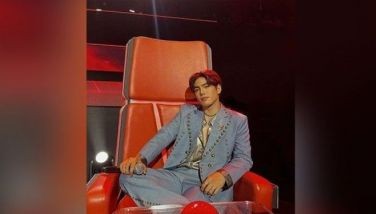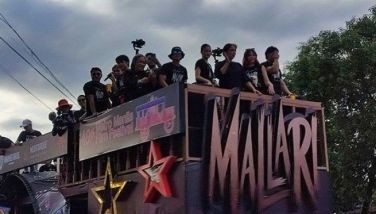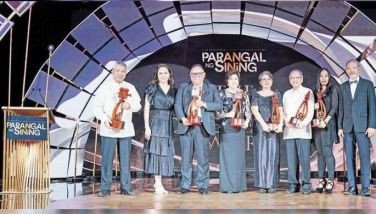Showbiz and people power
February 25, 2006 | 12:00am
 Any event in this country always has something showbiz in it – even the first People Power in EDSA 20 years ago. Below, let us trace the events related to showbiz that led to the first EDSA revolution in February 1986 and its immediate aftermath in the world of local movies.
Any event in this country always has something showbiz in it – even the first People Power in EDSA 20 years ago. Below, let us trace the events related to showbiz that led to the first EDSA revolution in February 1986 and its immediate aftermath in the world of local movies.
What triggered the first EDSA revolt in 1986 was the assassination of Sen. Benigno Aquino Jr. on Aug. 21, 1983. Widespread street rallies were immediately organized after that and in attendance were politicized showbiz figures, several of them friends of film director Lupita Kashiwahara and Butz Aquino – but generally people in the entertainment profession who felt that it was about time the Marcos regime ended. At that point, it was already easy to politicize showbiz people because months earlier they had formed the Concerned Artists of the Philippines, which fought against repressive censorship in the land. Their battle cry: Free the Artists!
In January 1984, the Film Academy Classification Board (FACB) became fully operational with Nestor U. Torre as chairman. Unfortunately, the FACB had no teeth because it was still the Board of Review for Motion Pictures and Television (BRMPT) under the late Maria Kalaw Katigbak that was still being enforced in the country. The FACB, however, taught industry members self-regulation and basically how to police their own ranks.
At the Rizal Theater in March 1984, the eighth Gawad Urian was held and anti-Marcos and anti-censorship sentiments were freely expressed by the hosts (among them, Bibeth Orteza), presentors and winners. Ironically, Ms. Katigbak had to be in the audience that time and showed no emotion all throughout the program.
Almost a year after the assassination of Ninoy, more people in show business felt freer to express their political views. Bayan Ko was the song of the season and in-demand singers were Freddie Aguilar, Coritha and the APO. In spite of the repression, filmmakers were still able to come up with truly quality movies in 1984: ‘Merika, Bulaklak ng City Jail, Boatman, Misteryo sa Tuwa, Condemned, Alyas Baby Tsina, Adultery and, of course, Sister Stella L., which eventually was declared Best Picture of the Year. On television, an episode of Two for the Road (directed by Maria Montelibano) on Channel 2 was banned and Ms.ellaneous of Tina Revilla and Maan Hontiveros was always in trouble with the BRMPT.
By 1985, more and more showbiz people were making themselves visible in the opposition camp: Noel Trinidad and Subas Herrero of Champoy, Celeste Legaspi, Leah Navarro, etc.
It was also this year when Kris Aquino came out as guest in the late Inday Badiday’s See-True, which got a still unmatched 80 percent in the ratings sheets.
Atty. Dong Puno’s Viewpoint on Channel 7 was becoming the voice of the opposition and the network’s news programs were the only credible newscasts because GMA 7 was the only station that was not controlled by Marcos and his cronies.
More quality local films were produced in 1985: Hinugot sa Langit, Paradise Inn, Bomba Arienda, Miguelito: Ang Batang Rebelde, Scorpio Nights (the most controversial movie of the year) and Kapit sa Patalim (Bayan Ko), which really had rough sailing with the censors and had to go to court just to be able to get exhibited in local cinemas.
In October of 1985, the BRMPT was abolished and put in its place was the Movie & Television Review and Classification Board (MTRCB). Juan Sison was designated a chief and among the members were industry practitioners.
At the height of the snap elections on Feb. 7, 1986, sex flicks were allowed to be exhibited without cuts and the two movies that made a killing at the box-office were Silip and Perfumed Gardens. Again, this was a tactical device from the government’s end to distract the public from the social-political issues that stared at them that very moment.
During the four-day bloodless revolt, it was June Keithley’s voice on Bombo Radyo that was most audible. Movie, TV and theater people were also very visible in EDSA – all of them in Cory yellow.
After EDSA I, Armida Siguion-Reyna was made to head temporarily the MTRCB – until Manuel Morato was designated as chief. Armida eventually had another crack at the post in 1998.
The stage became so alive with productions like Tessie Tomas’ Meldita and Bongbong and Kris.
The Lopezes’ ABS-CBN reopened and among its early programs were TV Patrol, Loren Legarda’s Pep Talk and World Tonight (with Loren and Angelo Castro Jr.)
The year ended with another controversy: the 1986 Metro Manila Film Festival – when the jurors (headed by Tingting Cojuangco) refused to give first and second best pictures during the awards presentation, which was the right thing to do, except that a lot of people didn’t agree with that and they raised a howl over this. As you can see, we’ve already had an EDSA I, an EDSA II and an unofficial EDSA III – plus several other attempts to destabilize the administration and the MMFF is still plagued with controversies to this day. I don’t know how many more EDSAs we are going to see before this annual film festival finally gets in shape.
BrandSpace Articles
<
>
- Latest
- Trending
Trending
Latest
Trending
Latest
Recommended
































